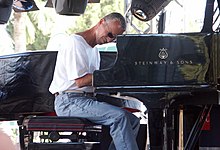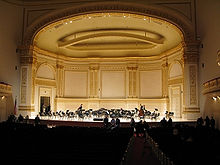The Carnegie Hall Concert
| The Carnegie Hall Concert | ||||
|---|---|---|---|---|
| Keith Jarrett music album | ||||
|
Publication |
September 22, 2006 |
|||
|
admission |
September 26, 2005 |
|||
| Label (s) | Carnegie Hall, New York City | |||
|
Format (s) |
CD |
|||
|
jazz |
||||
|
Title (number) |
15th |
|||
|
running time |
110: 11 |
|||
| occupation | Keith Jarrett | |||
|
Location (s) |
Isaac Stern Auditorium, Carnegie Hall, New York |
|||
|
||||
The Carnegie Hall Concert is a jazz album by the American pianist Keith Jarrett released in 2006 on ECM Records .
The album
The album contains recordings of an improvisational solo concert by the pianist that were recorded on September 26, 2005 in the Isaac Stern Auditorium of Carnegie Hall , New York City .
The album has a total of fifteen tracks, spread over 2 CDs, with a total playing length of 110 minutes and 11 seconds.
In his solo concerts it is Keith Jarrett's claim to create music “out of nothing” without any musical preliminary considerations and without a plan. He explains: “It is always like stepping on stage naked. The most important thing in a solo concert is the first note I play, or the first four notes. If they have enough tension, the rest of the concert will follow naturally. Solo concerts are pretty much the most revealing psychological self-analysis that I can imagine. "For Wolfgang Sandner - the artist's German biographer - Jarrett's solo concerts are" visits to the workshop or the delivery room, open-heart music operations under public supervision. " And his "pianistic solo improvisations form a continuum in Jarrett's oeuvre, in which ... the stylistic characteristics are always similar, the ideas and techniques mix virtuously."
The first ten tracks on the album are the artist's piano improvisations outlined above. As with his solo concert Radiance (ECM, 2005), published last year, there are shorter improvisations with a playing time of 3.5 to a maximum of 10 minutes. Jarrett - known from the past for his long and sprawling piano improvisations - explains the change in his playing practice as follows: “If I start playing and after a minute and a half feel that the piece is over, I'll stop. It is the freedom to quit when quitting seems right. I got myself into a situation that was a little too complicated, in which the rules that I had made for myself dominated me - instead of having simple rules that lead me to something new. ”And Wolfgang Sandner comments on them over time Changed improvisational practice in Keith Jarrett's book as follows: “Compared to the early, let's say wildly determined recordings, the later recordings seem ... more structurally contoured, even if he piles up the tonal masses with highly virtuoso dexterity and the tone consumption is enormous ... The impression is now great more like ad hoc composing when Jarrett is improvising. That means, where in the past a piece got out of joint, seemed abruptly broken off or sound layers collided that absolutely did not want to be connected, here - despite the speed with which everything happens - a superordinate design becomes noticeable, the will, to put something together that belongs together. "
Jazzecho magazine provides a brief summary of the solo improvisations : “The program looks like a foray into American music history. It contains boogie-woogie, gospel, blues, funk, country, elegiac hymns. It's a rollercoaster of moods, sometimes intensely lyrical or more classic-impressionistic, then again gripping funky or tonally completely free. "
After his solo improvisations, Keith Jarrett gave a total of five encores. The first encore The Good America and the fourth encore True Blues are improvisations based on new compositions by the artist. The second encore Paint My Heart Red and the third encore My Song are interpretations of older compositions by the pianist. Jarrett had already recorded the title Paint My Heart Red on the album Concerts (ECM, 1981). And the title My Song was first interpreted on the album of the same name by the European Quartet My Song (ECM, 1977) with Keith Jarrett (piano), Jan Garbarek (tenor and soprano saxophone), Palle Danielson (bass) and Jon Christensen (drums). The fifth and final encore, Time on My Hands , is the interpretation of a popular jazz standard from 1930 with music by Vincent Youmans and lyrics by Harold Adamson and Mack Gordon ; a song that has already been interpreted by numerous jazz musicians (including Django Reinhardt , Chet Baker and Billie Holiday ).
After the album The Carnegie Hall Concert , released in 2006, it took two years until the next album with Keith Jarrett's solo improvisations, Paris / London - Testament (ECM, 2008), was released.
Contributors
The musician and his instrument
- Keith Jarrett - piano
The production staff
- Sascha Kleis - design
- Martin Pearson - recording technology
- Richard Dates - Photography
- Keith Jarrett - Photography
- Manfred Eicher - producer
The playlist
- Keith Jarrett: The Carnegie Hall Concert (ECM 1989/90 (985 6224))
- Part I - 9:56
- Part II - 3:32
- Part III - 4:44
- Part IV - 5:19
- Part V - 9:54
- Part VI - 6:50
- Part VII - 8:35
- Part VIII - 5:19
- Part IX - 8:25
- Part X - 9:46
- The Good America - 6:47
- Paint My Heart Red - 8:30
- My Song - 8:04
- True Blues - 7:00
- Time on My Hands (Harold Adamson, Mack Gordon, Vincent Youmans) - 7:30
- With the exception of title 15, all compositions are by Keith Jarrett.
The reception
The reception of the album in the German-language media is consistently positive. Downright effusive Expresses Michael Naura in the time : " The Carnegie Hall Concert belongs to the most fascinating thing I've ever heard on a wing, in an acoustic aura that makes the Carnegie Hall so magical. ... Keith Jarrett transports me to alien realms. "
Matthias Inhoffen sees it similarly in Audio Live magazine : “Solo on the piano, Jarrett freed himself from the pressure of improvising over long periods of time; he seems relaxed, concentrated and just bubbling over with ideas. In a kind of suite consisting of two five movements plus five encores, he conjures up the earthiness of the blues as well as the lyrical delicacy of a ballad, and even in hectic virtuoso tricks he captivates the listener with vitality and form awareness. A great moment in a great live sound. "The Jazz Echo comments:" For many critics it was clear after the concert that they had witnessed the creation of a new classic album, which - although completely different - does not compare with the fabulous 'Cologne Concert' needs to shy away. "For Reinhard Köchl from Jazz thing the album is" only 30 years after Cologne a bit older and therefore a bit more fascinating. "And for H. Sterner in the magazine stereoplay Keith Jarrett is" a key magician of the extra class " . Only Jazzcity expresses itself more cautiously , who think that the concert "shows a great artist, but not consistently on the summit."
The international media react in a similarly positive manner. Thom Jurek's review for Allmusic gave it 4 out of 5 stars with the reasoning: “This is a Jarrett solo set for the ages; it shows ... his renewed and restless commitment to the music and to himself as an artist. "" This is an extraordinary recording that captures a magical concert, "comments Larry Greenhill for stereophiles. For David Fricke in Rolling Stone magazine it is “a two-CD document from an extraordinary night soaring last fall in New York.” And Richard Koch said for BBC Music Magazine : “There are no other pianists in jazz yet, who can conjure up moments of such enchanting beauty from the keyboard like this man. ”The Penguin Guide to Jazz awarded 4 out of 4 stars.
literature
- Wolfgang Sandner : Keith Jarrett. A biography. Rowohlt, Berlin 2015, ISBN 978-3-644-11731-0
- Richard Cook , Brian Morton : The Penguin Guide to Jazz Recordings . 9th edition. Penguin, ISBN 978-0-14-103401-0 .
Web links
- Keith Jarrett at jazzdisco.org
- Keith Jarrett at discogs.com
- Keith Jarrett at allmusic.com
- Keith Jarrett at ecmrecords
- Keith Jarrett at keithjarrett.org
- Keith Jarrett at youtube.com
Individual evidence
- ↑ a b Information on the album. In: ecmrecords.com. Retrieved February 9, 2017 : “If I start to play and a minute-and-a-half later I feel a piece is over, I'll stop. It's the freedom to stop when stopping seems correct. I had got myself locked into a slightly too complicated situation where the rules I had made for myself had been governing me - instead of making simple rules that could take me somewhere new. "
- ↑ quoted from Peter Rüedi: Keith Jarrett, the eyes of the heart . In: Siegfried Schmidt-Joos: Idols . 5 Only the sky is the limit . Ullstein, Berlin 1985
- ↑ a b c Wolfgang Sandner: Keith Jarrett. A biography . Rowohlt, Berlin 2015, ISBN 978-3-644-11731-0 .
- ↑ a b Information on the album. In: jazzecho.de. Retrieved February 9, 2017 .
- ↑ Michael Naura : quoted from ecmrecords.com. In: The time . Retrieved February 9, 2017 .
- ↑ Matthias Inhoffen: quoted from ecmrecords.com. In: Audio Live. Retrieved February 9, 2017 .
- ↑ Reinhard Köchl: quoted from ecmrecords.com. In: Jazzthing. Retrieved February 9, 2017 .
- ↑ H. Sterner: quoted from jpc.de. In: stereoplay. Retrieved February 9, 2017 .
- ↑ Review of the album. In: jazzcity.de. Retrieved February 9, 2017 .
- ↑ Review of the album. In: allmusic.com. Retrieved February 9, 2017 : “This is a Jarrett solo set for the ages; it showcases, since his full return in 1997, his renewed and restless commitment to the music and to himself as an artist. "
- ↑ Larry Greenhill: quoted from ecmrecords.com. In: Stereophile. Retrieved on February 9, 2017 : "This is an extraordinary recording that captures a magical concert."
- ↑ David Fricke: quoted from ecmrecords. In: Rolling Stone. Retrieved on February 9, 2017 : "two-CD document of an extraordinary night in flight last fall in New York."
- ↑ Richard Koch: quoted from ecmrecords.com. In: BBC Music Magazine. Accessed February 9, 2017 : "There's still no other pianist in jazz who can conjure moments of bewitching beauty out of the keyboard like this man."
- ^ Richard Cook, Brian Morton: The Penguin Guide to Jazz Recordings . 9th edition. Penguin, ISBN 978-0-14-103401-0 , pp. 771 .

